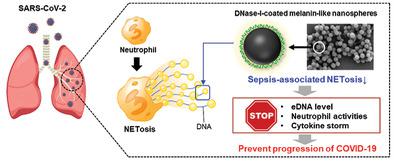Our official English website, www.x-mol.net, welcomes your
feedback! (Note: you will need to create a separate account there.)
Bioinspired DNase‐I‐Coated Melanin‐Like Nanospheres for Modulation of Infection‐Associated NETosis Dysregulation
Advanced Science ( IF 14.3 ) Pub Date : 2020-10-20 , DOI: 10.1002/advs.202001940 Hee Ho Park 1 , Wooram Park 2 , Yun Young Lee 3 , Hyelim Kim 4 , Hee Seung Seo 5 , Dong Wook Choi 6 , Ho-Keun Kwon 7 , Dong Hee Na 8 , Tae-Hyung Kim 9 , Young Bin Choy 3 , June Hong Ahn 10 , Wonhwa Lee 11 , Chun Gwon Park 12, 13, 14, 15
Advanced Science ( IF 14.3 ) Pub Date : 2020-10-20 , DOI: 10.1002/advs.202001940 Hee Ho Park 1 , Wooram Park 2 , Yun Young Lee 3 , Hyelim Kim 4 , Hee Seung Seo 5 , Dong Wook Choi 6 , Ho-Keun Kwon 7 , Dong Hee Na 8 , Tae-Hyung Kim 9 , Young Bin Choy 3 , June Hong Ahn 10 , Wonhwa Lee 11 , Chun Gwon Park 12, 13, 14, 15
Affiliation

|
The current outbreak of the beta‐coronavirus (beta‐Cov) severe acute respiratory syndrome coronavirus 2 (SARS‐CoV‐2) began in December 2019. No specific antiviral treatments or vaccines are currently available. A recent study has reported that coronavirus disease 2019 (COVID‐19), the disease caused by SARS‐CoV‐2 infection, is associated with neutrophil‐specific plasma membrane rupture, and release excessive neutrophil extracellular traps (NETs) and extracellular DNAs (eDNAs). This mechanism involves the activation of NETosis, a neutrophil‐specific programmed cell death, which is believed to play a crucial role in COVID‐19 pathogenesis. Further progression of the disease can cause uncontrolled inflammation, leading to the initiation of cytokine storms, acute respiratory distress syndrome (ARDS), and sepsis. Herein, it is reported that DNase‐I‐coated melanin‐like nanospheres (DNase‐I pMNSs) mitigate sepsis‐associated NETosis dysregulation, thereby preventing further progression of the disease. Recombinant DNase‐I and poly(ethylene glycol) (PEG) are used as coatings to promote the lengthy circulation and dissolution of NET structure. The data indicate that the application of bioinspired DNase‐I pMNSs reduce neutrophil counts and NETosis‐related factors in the plasma of SARS‐CoV‐2 sepsis patients, alleviates systemic inflammation, and attenuates mortality in a septic mouse model. Altogether, the findings suggest that these nanoparticles have potential applications in the treatment of SARS‐CoV‐2‐related illnesses and other beta‐CoV‐related diseases.
中文翻译:

仿生 DNase-I 涂层黑色素样纳米球用于调节感染相关的 NETosis 失调
当前β冠状病毒 (beta-Cov) 严重急性呼吸综合征冠状病毒 2 (SARS-CoV-2) 的爆发始于 2019 年 12 月。目前尚无特定的抗病毒治疗或疫苗。最近的一项研究报道,由 SARS-CoV-2 感染引起的 2019 冠状病毒病 (COVID-19) 与中性粒细胞特异性质膜破裂有关,并释放过量的中性粒细胞胞外陷阱 (NET) 和胞外 DNA (eDNA) )。这种机制涉及 NETosis 的激活,NETosis 是一种中性粒细胞特异性程序性细胞死亡,被认为在 COVID-19 发病机制中发挥着至关重要的作用。疾病的进一步进展可能导致不受控制的炎症,导致细胞因子风暴、急性呼吸窘迫综合征(ARDS)和败血症的发生。据报道,DNase-I 包被的黑色素样纳米球(DNase-I pMNSs)可减轻脓毒症相关的 NETosis 失调,从而防止疾病进一步进展。使用重组DNase-I和聚乙二醇(PEG)作为涂层来促进NET结构的长时间循环和溶解。数据表明,应用仿生 DNase-I pMNS 可以减少 SARS-CoV-2 脓毒症患者血浆中的中性粒细胞计数和 NETosis 相关因子,减轻全身炎症,并降低脓毒症小鼠模型的死亡率。总而言之,研究结果表明这些纳米颗粒在治疗 SARS-CoV-2 相关疾病和其他 β-CoV 相关疾病方面具有潜在应用。
更新日期:2020-12-03
中文翻译:

仿生 DNase-I 涂层黑色素样纳米球用于调节感染相关的 NETosis 失调
当前β冠状病毒 (beta-Cov) 严重急性呼吸综合征冠状病毒 2 (SARS-CoV-2) 的爆发始于 2019 年 12 月。目前尚无特定的抗病毒治疗或疫苗。最近的一项研究报道,由 SARS-CoV-2 感染引起的 2019 冠状病毒病 (COVID-19) 与中性粒细胞特异性质膜破裂有关,并释放过量的中性粒细胞胞外陷阱 (NET) 和胞外 DNA (eDNA) )。这种机制涉及 NETosis 的激活,NETosis 是一种中性粒细胞特异性程序性细胞死亡,被认为在 COVID-19 发病机制中发挥着至关重要的作用。疾病的进一步进展可能导致不受控制的炎症,导致细胞因子风暴、急性呼吸窘迫综合征(ARDS)和败血症的发生。据报道,DNase-I 包被的黑色素样纳米球(DNase-I pMNSs)可减轻脓毒症相关的 NETosis 失调,从而防止疾病进一步进展。使用重组DNase-I和聚乙二醇(PEG)作为涂层来促进NET结构的长时间循环和溶解。数据表明,应用仿生 DNase-I pMNS 可以减少 SARS-CoV-2 脓毒症患者血浆中的中性粒细胞计数和 NETosis 相关因子,减轻全身炎症,并降低脓毒症小鼠模型的死亡率。总而言之,研究结果表明这些纳米颗粒在治疗 SARS-CoV-2 相关疾病和其他 β-CoV 相关疾病方面具有潜在应用。











































 京公网安备 11010802027423号
京公网安备 11010802027423号